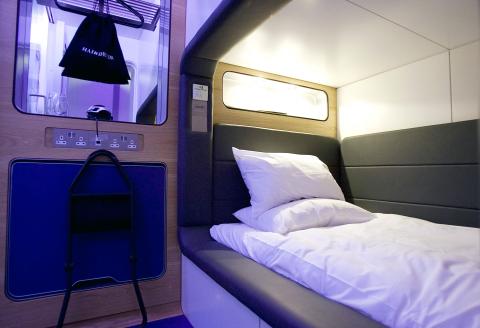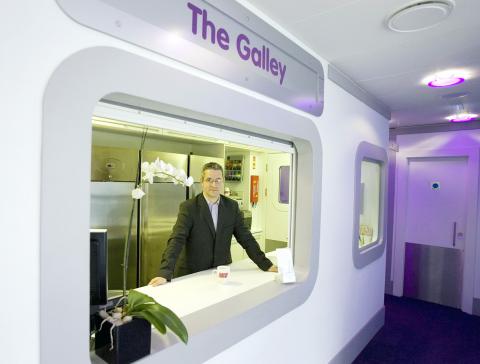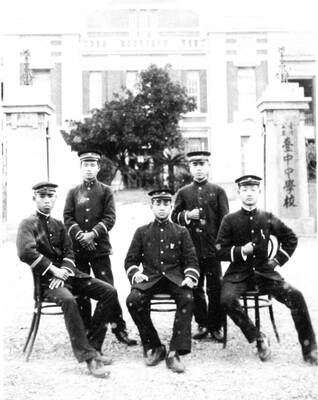It’s a seriously sweltering New York afternoon as I limp gratefully off the street into the slick, glass-fronted Yotel. In stark, cool contrast to the hectic, less-than-lovely corner of 10th Avenue and 42nd Street outside, the airy lobby feels like the Starship Enterprise. To my left, a bank of airport-style touch-screen check-in machines; to my right, the Yobot, 18m of hydraulic arm guarding a giant wall of left-luggage lockers.
The baggage beast is at rest, but the smartly attired staff, six of them in Star Trek-issue gray and purple uniforms, bid me a cheery welcome, and Julio, “my” doorman, ushers me to the self-service screens. Too many unexpected items in the bagging areas at my local supermarket have made me suspicious of unmanned automation, but Julio is on hand to help, and the machine digests my details and spits out a room key.
I must admit to having had reservations about the place. Yotel is the brainwave of Yo! Sushi supremo Simon Woodroffe, and his business partner, CEO Gerard Greene. The idea came to Woodroffe in 2007 after he was bumped up to first class on a flight and decided to try combining the clever use of space in Japanese pod hotels with the luxury elements of first-class air travel. Three smaller airport Yotels have proved successful at London’s Heathrow and Gatwick and Amsterdam’s Schiphol, but the US$315 million New York outpost, which opened last week, is the pair’s first city venture, and with 669 “cabin” rooms on over 27 floors of “affordable luxury,” it’s no minor undertaking.

Photo: Bloomberg
It’s in a plum spot in Midtown, two blocks from Port Authority bus station (handy for airport connections), three blocks from Times Square, and four blocks from the airy oasis of Bryant Park and the ringing tills of Fifth Avenue. Central Park, the galleries and museums are a 30-minute stroll (or a US$7 cab ride) away; even SoHo is just a 10-minute subway trip.
My premium cabin, the basic room, begins at US$149 a night (plus tax), which is not to be sniffed at in a city where affordable accommodation is found only in far-flung boroughs or bed-bug-happy hostels. The boutique hotels generally begin at around US$300 a night for a room built for a Borrower. For US$149, I feared an airless, beach-hut-size hovel, but I’m pleasantly surprised. If I had a cat, I could certainly swing it. Yes, it is compact, at 12m2, but it’s white and bright, with soft purple backlighting and a cunning use of space. The similarity to a Virgin upper-class cabin should probably not be surprising, since Soho (London) architects Softroom worked on both.
The queen-size motorized bed is stored upright, giving extra floor space in front of the wall-mounted flat-screen TV, and a tray-table is stowed away in the bed’s armrest. There’s a neat work desk, an office-style chair and small storage spots underneath the TV for keys, wallet, phone and other travel ephemera. The bathroom too — though a little reminiscent of a clap clinic — is well-designed, with a monsoon shower, square sink and sliding glass door to the toilet, to preserve modesty and mystique.

Photo: Bloomberg
I stand 160cm on a tall day, so a compact cabin isn’t an issue for me. So in the interests of thorough research — and thorough research alone — I invited a gentleman friend of greater stature to stop by and give me the verdict from his rather more lofty perspective. Even he found no need to fold himself up; once we’d located the button to get the bed into the flat position, he could happily stretch his full 193cm self out unfettered. If you’re reading this, Mum, he kept one large foot on the floor at all times.
The only spatial issue is really that of storage: There’s no wardrobe, just six hangers on two open hooks. Suitcases can be stashed away under the bed, but those heading to New York City to help the ailing American economy would struggle to store armfuls of Bloomingdale’s bags.
Larger cabins are available, from the corner rooms (15m2 and only US$20 a night more), to the first-class cabins, some of which feature terraces, hot tubs and outdoor dining tables. Three VIP suites, starting at US$1,500, are blingtastic shag-pads with fireplaces, pool tables and pumping sound systems.
Designed with the ethos of airline seating in mind, Yotels operate to a philosophy of functionality, so you won’t find fripperies such as bathrobes, slippers or minibars in any of the rooms. Instead, there’s free fast-connection Wi-Fi, complimentary continental breakfast, and guest fridges in the galley kitchens on each floor. There’s no shortage of spacious public areas on the fourth floor, and the Studiyo has a cinema screen and yoga space. At night, these morph into social spaces for drinking, dining and hanging out.
Back down on the fourth floor terrace, the sun is setting over the Hudson river two blocks to the west, throwing a golden glow over the Gotham skyscrapers of Midtown. The Chrysler Building glitters to the east as we sink exceptionally good cocktails in New York’s newest rooftop bar.
My leggy companion and I mop up a few mango and ginger martinis at the hotel’s restaurant, Dohyo, named after the Japanese sumo wrestling ring, and where, like the cabin beds, the central bench tables are motorized, sinking into the wooden floor after service ends to form a dance floor. The Asian-fusion menu is made up of small sharing plates — pork belly tacos, spicy tuna sushi, seared scallops and salt-and-pepper calamari — most priced between US$6 and US$12. With the atmosphere of an upmarket Wagamama, Dohyo deserves to be a destination in itself, particularly in this culinary dead-zone that is called (appropriately) Hell’s Kitchen.
Sated from the sumo ring, I wander back upstairs to my lodgings, and draw the blackout blind. The six lanes of traffic outside are silent, thanks to the super-insulated windows. The thing that does disturb my dreams, unfortunately, is the incessant heavy slamming of other cabin doors along the corridor.
So the Yotel ain’t the Ritz, but it isn’t aiming to be. Give me a good location, a relaxed vibe and a reasonable price over a white-gloved waiter and a US$40 breakfast surcharge any day. And give me another scrumptious mango martini as the sun sets over New York City.
Note: Double rooms at Yotel (yotel.com) start at US$149 (special rates for July and August this year).

In the March 9 edition of the Taipei Times a piece by Ninon Godefroy ran with the headine “The quiet, gentle rhythm of Taiwan.” It started with the line “Taiwan is a small, humble place. There is no Eiffel Tower, no pyramids — no singular attraction that draws the world’s attention.” I laughed out loud at that. This was out of no disrespect for the author or the piece, which made some interesting analogies and good points about how both Din Tai Fung’s and Taiwan Semiconductor Manufacturing Co’s (TSMC, 台積電) meticulous attention to detail and quality are not quite up to

April 28 to May 4 During the Japanese colonial era, a city’s “first” high school typically served Japanese students, while Taiwanese attended the “second” high school. Only in Taichung was this reversed. That’s because when Taichung First High School opened its doors on May 1, 1915 to serve Taiwanese students who were previously barred from secondary education, it was the only high school in town. Former principal Hideo Azukisawa threatened to quit when the government in 1922 attempted to transfer the “first” designation to a new local high school for Japanese students, leading to this unusual situation. Prior to the Taichung First

Chinese Nationalist Party (KMT) Chairman Eric Chu (朱立倫) hatched a bold plan to charge forward and seize the initiative when he held a protest in front of the Taipei City Prosecutors’ Office. Though risky, because illegal, its success would help tackle at least six problems facing both himself and the KMT. What he did not see coming was Taipei Mayor Chiang Wan-an (將萬安) tripping him up out of the gate. In spite of Chu being the most consequential and successful KMT chairman since the early 2010s — arguably saving the party from financial ruin and restoring its electoral viability —

The Ministry of Education last month proposed a nationwide ban on mobile devices in schools, aiming to curb concerns over student phone addiction. Under the revised regulation, which will take effect in August, teachers and schools will be required to collect mobile devices — including phones, laptops and wearables devices — for safekeeping during school hours, unless they are being used for educational purposes. For Chang Fong-ching (張鳳琴), the ban will have a positive impact. “It’s a good move,” says the professor in the department of